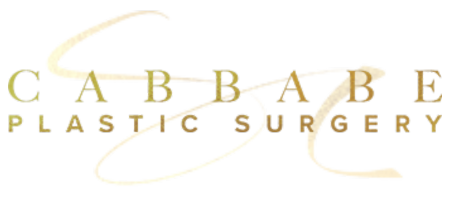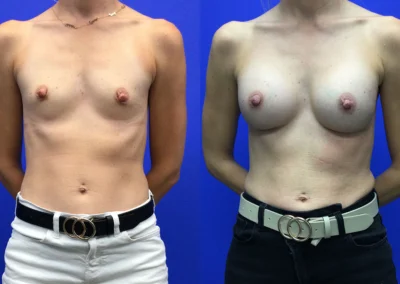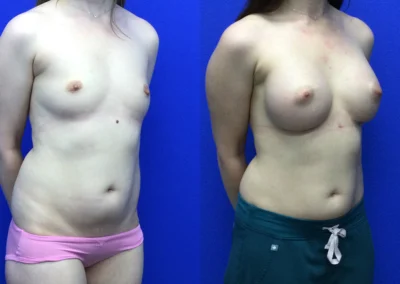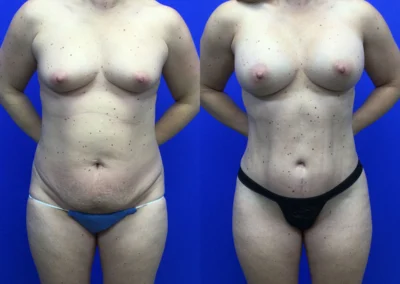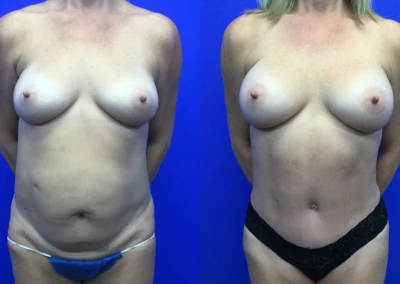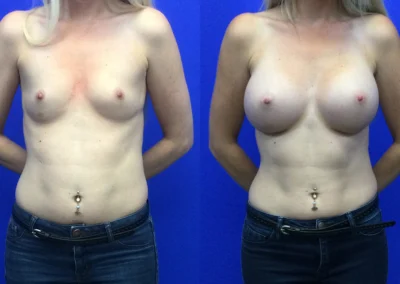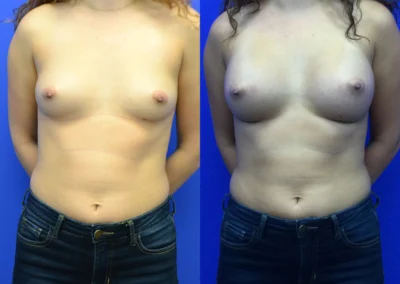Breast Augmentation in St. Louis
Natural, Long-Lasting Results With Dr. Samer Cabbabe
Breast augmentation—also called augmentation mammoplasty—is a cosmetic procedure that increases breast size, improves shape, and restores youthful fullness. At Cabbabe Plastic Surgery in St. Louis, internationally recognized plastic surgeon Dr. Samer Cabbabe offers advanced implant and fat-transfer techniques to deliver natural, lasting results with a focus on patient safety, rapid recovery, and long-term breast health.
Why Women Choose Breast Augmentation
Breast enhancement can:
- Restore breast volume lost after pregnancy, breastfeeding, or weight loss
- Improve body proportions and clothing fit
- Correct congenital asymmetry or deformities
- Reconstruct the breast after mastectomy or injury
- Boost self-confidence and body image
Dr. Cabbabe’s Rapid-Recovery Technique
To minimize pain and downtime, Dr. Cabbabe employs Rapid Recovery / Flash Recovery methods:
- Long-acting local anesthetics and anti-inflammatory medications before and during surgery
- Meticulous, blood-sparing surgical technique
- Early arm range-of-motion exercises the day after surgery
Most patients are showering the next day and return to daily activities within 1–2 weeks.
Types of Breast Augmentation
Breast Implants: Breast implants can be filled with silicone gel or saline (sterile salt water). Dr. Cabbabe offers full access to every FDA-approved breast implant manufacturer—including Motiva®, Allergan®, Mentor®, and Sientra®—with no financial ties to any company. This independence allows him to recommend the exact implant that best matches your anatomy and goals, without bias toward any brand.
- Silicone implants: softer, more natural feel, lower rippling
- Saline implants: adjustable size, immediate detection of rupture
- Motiva® smooth implants (FDA-approved 2025): lower capsular contracture rates even when placed above
All implants are FDA-approved and come with lifetime warranties for rupture and early contracture coverage.
Fat Transfer (Natural Augmentation)
For patients seeking modest enhancement without implants, fat grafting transfers your own purified fat—harvested with liposuction—to the breasts through tiny incisions. Important limitation: fat transfer cannot reliably fill the upper pole of the breast, which means it cannot create the same roundness or upper fullness that an implant provides. Fat grafting is best suited for gentle volume increases and soft shaping rather than dramatic cleavage or upper-pole projection.
Implant Placement Options – Customized for Your Body
Choosing the correct implant pocket and incision site is critical for a natural look, long-term stability, and minimal complications. Unlike many surgeons who rely on a single approach, Dr. Samer Cabbabe customizes implant placement for every patient based on chest width, tissue quality, and aesthetic goals.
Subfascial (Above the Muscle)
Also known as “above the muscle” placement, the subfascial pocket positions the implant beneath the thin layer of pectoral fascia but on top of the muscle. Dr. Cabbabe favors this advanced technique in many patients because it:
- Sits in position immediately—there is no long waiting period for the implants to “drop” or settle
- Reduces animation deformity (visible implant movement when flexing the chest)
- Decreases muscle pain and recovery discomfort
- Prevents waterfall deformity, which can occur when implants are placed below the muscle in patients with looser skin or when a lift is performed
- Creates enhanced cleavage in wider chests by allowing implants to sit closer together
Most surgeons do not routinely perform true subfascial augmentation because it requires greater technical skill and meticulous pocket creation—skills Dr. Cabbabe has mastered and teaches internationally.
Below the Muscle (Dual Plane)
Traditional dual-plane placement—under the muscle in the upper breast and under the gland in the lower breast—can be appropriate for select patients, but it carries several significant drawbacks:
- Implant settling period – implants must “drop” or settle over several months before reaching their final position
- Lateral displacement – the pectoralis muscle can gradually push the implant outward toward the armpit
- Higher risk of bottoming out – muscle pressure may drive the implant downward over time, especially in patients with loose skin or when mesh is used for support
- Greater chance of waterfall deformity, where natural breast tissue sags over the implant
- Mesh is less reliable – while mesh can sometimes help stabilize a dual-plane implant, it is not as dependable as the subfascial pocket for long-term support, particularly in patients with loose tissue or those needing a breast lift with implants
- Over-release complications – many surgeons release the pectoralis muscle too high in an effort to accommodate breasts with loose skin, which can lead to pain, animation deformity, and even symmastia (implants drifting toward the midline)
Because of these risks, Dr. Cabbabe often prefers subfascial placement to provide more stable cleavage, lower complication rates, and a softer, more natural look—especially in patients with lax skin or in combined breast-lift procedures.
Incision Options
Regardless of pocket choice, implants can be inserted through several approaches:
- Inframammary fold (under the breast) – preferred and most common for precise placement, excellent control, and a well-hidden scar
- Periareolar (around the nipple/areola) – generally not recommended because of a higher risk of capsular contracture, nipple sensation changes, and potential limitations for future breast lift procedures
- Transaxillary (armpit) – used selectively for patients who wish to avoid any breast scar, though less precise than inframammary
Breast Lifts When Needed
For women with significant breast laxity or drooping, Dr. Cabbabe often recommends a breast lift (mastopexy) in combination with augmentation. A lift allows him to:
- Optimize implant position for the best shape and support
- Reposition the nipple–areola complex to a youthful height
- Create long-lasting results by tightening the skin envelope and reducing the risk of future sagging
By addressing both skin excess and implant placement at the same time, a lift ensures the implant sits higher and the breast maintains its youthful contour over many years.
Unmatched Expertise
- Higher risk of bottoming out – muscle pressure may drive the implant downward over time, especially in patients with loose skin or when mesh is used for support
- Greater chance of waterfall deformity, where natural breast tissue sags over the implant
- Mesh is less reliable – while mesh can sometimes help stabilize a dual-plane implant, it is not as dependable as the subfascial pocket for long-term support, particularly in patients with loose tissue or those needing a breast lift with implants
- Over-release complications – many surgeons release the pectoralis muscle too high in an effort to accommodate breasts with loose skin, which can lead to pain, animation deformity, and even symmastia (implants drifting toward the midline)
- Because of these risks, Dr. Cabbabe often prefers subfascial placement to provide more stable cleavage, lower complication rates, and a softer, more natural look—especially in patients with lax skin or in combined breast-lift procedures.
Incision Options
Regardless of pocket choice, implants can be inserted through several approaches:
- Inframammary fold (under the breast) – preferred and most common for precise placement, excellent control, and a well-hidden scar
- Periareolar (around the nipple/areola) – generally not recommended because of a higher risk of capsular contracture, nipple sensation changes, and potential limitations for future breast lift procedures
- Transaxillary (armpit) – used selectively for patients who wish to avoid any breast scar, though less precise than inframammary
Breast Lifts When Needed
For women with significant breast laxity or drooping, Dr. Cabbabe often recommends a breast lift (mastopexy) in combination with augmentation. A lift allows him to:
- Optimize implant position for the best shape and support
- Reposition the nipple–areola complex to a youthful height
- Create long-lasting results by tightening the skin envelope and reducing the risk of future sagging
By addressing both skin excess and implant placement at the same time, a lift ensures the implant sits higher and the breast maintains its youthful contour over many years.
Unmatched Expertise in Breast and Body Contouring
Dr. Samer Cabbabe is an expert in breast implant surgery, drawing on over 15 years of complex breast reconstruction and revision experience spanning thousands of patients. This extensive background allows him to safely perform advanced implant placement techniques—including true subfascial augmentation—that many surgeons do not offer.
Because of his parallel expertise in high-definition body contouring, Dr. Cabbabe can combine breast augmentation with bra-roll and outer chest liposculpting, as well as skin removal in breast lifts when needed. For patients with very thin breast tissue or visible rippling, Dr. Cabbabe can also use acellular dermal matrix derived from human or pig skin to thicken the breast tissue and provide additional implant coverage, creating a smoother, more natural result.
This comprehensive skill set ensures that the breasts, chest wall, and surrounding torso are harmoniously shaped, delivering results that look balanced and natural from every angle.
Sizing and Custom Planning
During your consultation, Dr. Cabbabe will:
- Measure chest width and breast dimensions
- Provide in-office implant “sizing” with different volumes and profiles so you can physically see and feel the difference
- Combine implant sizing results, his surgical expertise, and your personal goals to determine the optimal implant size and projection for your body
- Recommend whether a breast lift, internal mesh bra, or human/pig skin dermal matrix should be combined for optimal shape, implant coverage, and longevity
Important Note on Imaging Technology: Dr. Cabbabe does not use or recommend 3-D imaging or virtual simulation tools for breast augmentation planning. These technologies cannot accurately account for skin thickness, elasticity, or the unique artistry and surgical skill of the operating surgeon, and they often mislead patients with results that do not reflect what is achievable in real life. Instead, Dr. Cabbabe relies on precise measurements, implant sizers, and his extensive surgical experience to guide implant selection and surgical planning.
Implant Style Options
To achieve your desired aesthetic, Dr. Cabbabe offers different types of silicone implants with varying cohesivity levels:
- Highly cohesive silicone implants – provide greater shape retention and a rounder, more projected “implant” look with increased upper pole fullness
- Softer silicone implants – allow more natural settling and a gentler, sloped contour for patients seeking a more natural look
By carefully selecting implant cohesivity and profile, Dr. Cabbabe tailors each augmentation to your preference for a natural, subtle enhancement or a fuller, more glamorous appearance.
Advanced Safety & Implant Monitoring
- Office ultrasound every 2–3 years checks for silent silicone rupture as an alternative to MRI.
- Dr. Cabbabe offers in-office screening ultrasounds to all implant patients, making it convenient and cost-effective to monitor implant integrity over time.
- FDA suggests MRI at 2 years and every 3 years thereafter—Dr. Cabbabe reviews these recommendations individually.
- Implant life expectancy averages around 15 years; rupture or capsular contracture may require replacement.
Recovery Timeline
- Surgery time: 1–2 hours (add 1–1.5 hours if combined with a breast lift)
- Back to daily activities: typically 24 hours for light tasks
- Return to work/exercise: usually 1–2 weeks depending on implant size and occupation
- Long-term settling:
- Subfascial implants: sit in their final position immediately
- Under-the-muscle implants: require a settling period for the implants to “drop” over 3–12 months
Ibuprofen is the primary pain reliever; narcotics are rarely needed thanks to Dr. Cabbabe’s multimodal pain-control strategy.
Breast Augmentation Pricing
The cost of breast augmentation varies for each patient based on:
- Implant type (silicone vs. saline, Motiva vs. traditional)
- Desired implant cohesivity (soft vs. highly cohesive)
- Need for a breast lift, dermal matrix, or mesh support
- Surgical facility and anesthesia fees
Because every procedure is customized, a personalized price quote is provided during your consultation after a full evaluation of your anatomy and goals. Financing options are available to help make surgery accessible.
Why Choose Dr. Samer Cabbabe
- Nationally recognized breast augmentation expert with thousands of successful implant surgeries
- 15+ years of complex breast reconstruction and revision experience, giving him unparalleled skill with challenging primary and revision cases
- Independent access to all major implant manufacturers—Motiva, Allergan, Mentor, and Sientra—with no financial ties, allowing truly unbiased implant selection
- Ability to use human or pig skin (acellular dermal matrix) to thicken tissue and reduce rippling when needed
- Offers different silicone implant options for either a natural look or a rounder, more “implant” look
- Uses implant sizing combined with expert consultation and patient preferences to determine the most accurate, personalized implant size and shape
- Offers in-office screening ultrasounds to monitor implants for silent rupture, providing convenient long-term safety
- Uses only FDA-approved implants with lifetime warranties
- International speaker at ASPS, ASAPS, and ISAPS meetings, teaching advanced breast and body-contouring techniques
- Known for natural, balanced results and a compassionate, personalized approach
Patients travel from across the U.S. and internationally to St. Louis to benefit from Dr. Cabbabe’s unique skill set.
Schedule Your Breast Augmentation Consultation
If you’re considering breast augmentation in St. Louis, trust your care to Dr. Samer Cabbabe, a surgeon known for natural results, rapid recovery, and the lowest complication rates.
